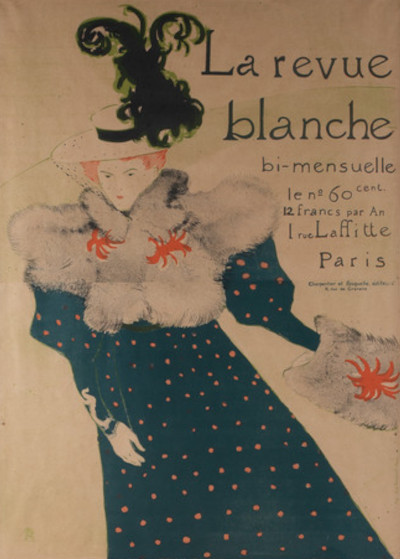La Revue Blanche is a lithographic print produced by French artist, Henri de Toulouse-Lautrec in 1895. The series was unusual in how many different colours the artist added to the final print.
The relatively simple composition captures an elegantly dressed woman in a long blue coat and stunning detail, with some lettering alongside her. The text delivers the advertising details, whilst a mood is created for the business from the image that it sits alongside. She wears a boater hat with flourishes reaching up to the top of the print, and then fur lines the top half of her coat. This stunning royal blue garment is covered in golden dots in a natural, approximate pattern that covers the entirety of her outfit. She also has a fur lined cover on one hand, with an orange motif that continues onto her fur scarf. The lady has red or pink hair and a narrow, feminine face. Her arms and hands are slim and lady like, and the overall brand oozes class and style. It is not known as to how many of the original release still exist today but there was one that featured in an auction in 2020 at Sotheby's which received an impressive price of $8,820.
An address is given in the text, as well as a price and the term 'bi-monthly". It must therefore be an advert for a special event, or some sort of publication. Toulouse-Lautrec would regularly be used by companies who wanted to promote their products and his illustration style was well suited to high end products and other items that might appeal to the middle and upper classes. He would also promote new novels, theatre shows and hat makers, among other things, and seemed to enjoy these small projects in which he would fairly quickly put together some poster designs. The best would then be released in batches of around one hundred at a time and numbered individually. The colours would be applied as an extra step, meaning the more complex colour combinations took him longer to achieve, though tended to be more impactful once completed.
La Revue Blanche is another example of how the artist managed to commercialise his career, though still managing to achieve a high level of artistic freedom. He also could pick and choose the businesses and individuals that he worked with, because so many wanted to work with him as his reputation soared across Paris. He most liked the local Montmartre-based entities and for some of them he would carry out several commissions. He became involved in the printing process as well, in order to ensure that the quality of his original designs was not lost once he had exited the production process.




